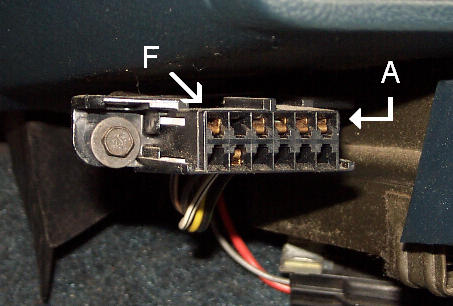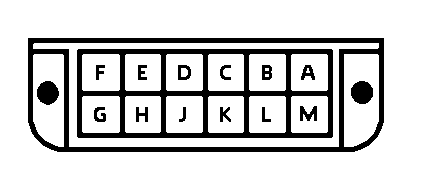Located under the radio and to the left of the ash tray, is the ALDL (Assembly Line Diagnostic Link). Sometimes also refered to as the ALCL (Assembly Line Communications Link).

The ALDL connector
The ALDL provides an easily accessible link to the ECM. This link can be used to read stored trouble codes, observe ECM and sensor operation or to put the ECM in a different mode for troubleshooting or service. Trouble codes can be retrieved as simply as by shorting an ALDL terminal to ground and counting flashes of the SES lamp. Or with the use of a Scan Tool, which reads the serial data output by the ECM, will allow not only the retrieval of stored trouble codes, but also the provide ability to observe the values each information sensor is sending to the ECM and the desired state of each ECM controlled device.

The ALDL terminals
| Position | Function | |
| A | Ground | |
| B | Diagnostic Terminal | |
| C | AIR Switching Solenoid | |
| D | SES Lamp (Serial Data) | |
| E | No Connection | |
| F | TCC Solenoid | |
| G | No Connection | |
| H | EGR Control Solenoid | |
| I | No Connection | |
| J | No Connection | |
| K | No Connection | |
| L | No Connection | |
| M | No Connection | |
| Ground (A) | Connects to the Instrument Panel Ground |
| Diagnostic Terminal (B) | Four modes of operation are available by use of the
Diagnostic Terminal. Each mode is selected by resistance to ground of the
Diagnostic Terminal:
|
| AIR Switching Solenoid (C) | This terminal is connected to the Air Switching Solenoid
Control Driver. This terminal will be grounded when the Air Switching Solenoid control circuit has been grounded (activated) by the ECM when the proper operating conditions have been meet. This terminal will also be grounded when the key is "ON" and the engine is "OFF". |
| SES Lamp (D) | This terminal is connected to the SES Lamp Driver. This terminal is also used for serial data when a Scan Tool is connected to the ALDL. This terminal will also be grounded when the key is "ON" and the engine is "OFF". |
| TCC Solenoid (F) | This terminal is connected to the TCC Solenoid Control
Driver. This terminal will be grounded when the TCC Solenoid control circuit has been grounded (activated) by the ECM. This terminal will also be grounded when the key is "ON" and the engine is "OFF". |
| EGR Solenoid (H) | This terminal is connected to the EGR Solenoid Control
Driver. This terminal will be grounded when the EGR Solenoid control circuit has been grounded (activated) by the ECM |
Serial Data from the ECM is transmited using the SES driver circuit. When placed into either ALDL or Backup mode, the ECM strobes the SES driver to output data at a rate of 160 baud or 160 bits per second. Every data packet is 20 bytes (25 bytes for '88), or 160 bits, and when overhead is included, takes about 1.25 seconds to transmit.
Serial Data will contain the following:
| Table of Contents | Back | Top of Chapter |
|
|
||
| Copyright © 1998-2024 by The Members of The Oldsmobile Mailing List. All Rights Reserved. This web site is not affiliated with General Motors or Oldsmobile. General Motors and Oldsmobile are trademarks of their respective companies. The owners and members of this site are not responsible for errors or inaccuracies. | ||